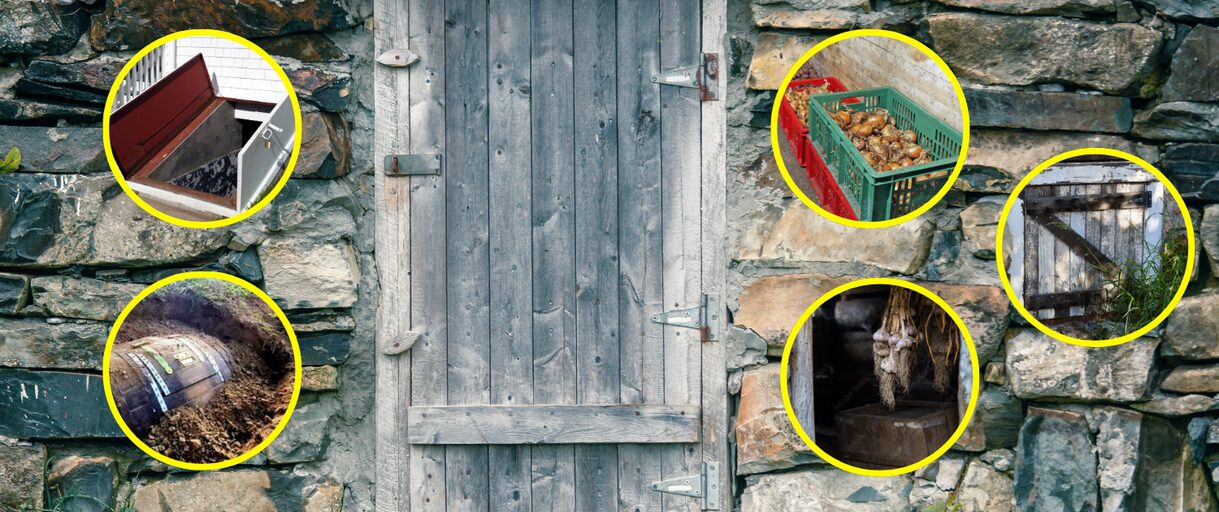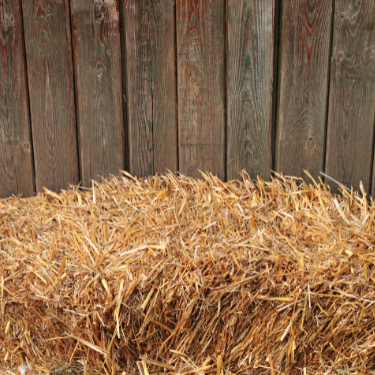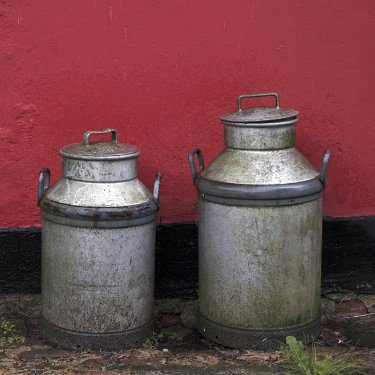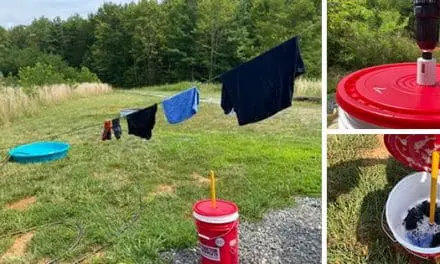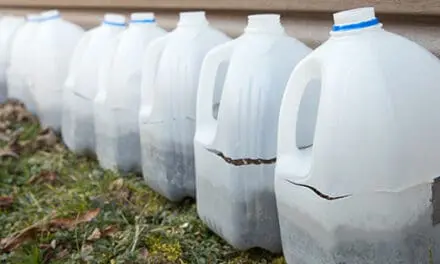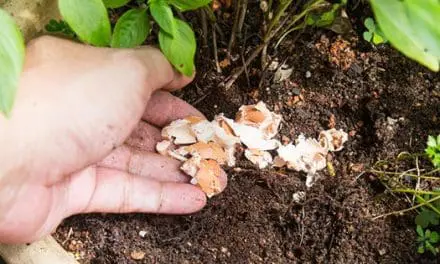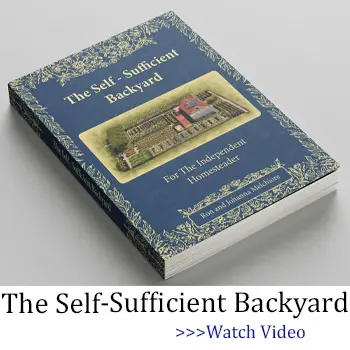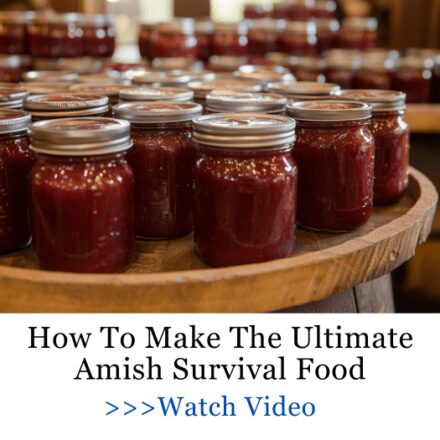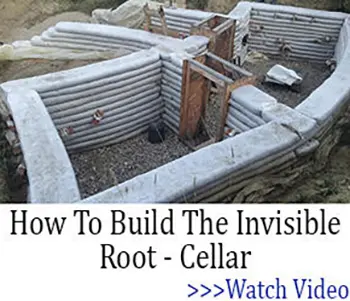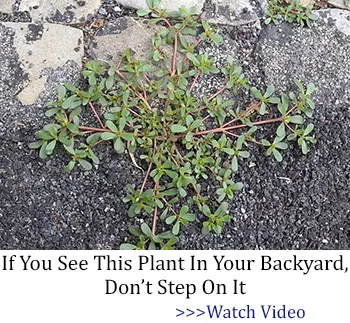Before electricity and grocery stores, families relied on these simple, cool earth shelters to keep their garden harvests and farm produce fresh through long winters and lean times.
These natural pantries weren’t complicated. They were clever, practical, and made from what was right around them. Whether it was a dugout under a hill or a cleverly buried wooden box, root cellars kept food fresh without power, helping folks stretch their supplies and survive tough seasons.
If you’re growing your own food, improvising a root cellar in your backyard is a game changer. I’m about to share with you 7 easy ways to improvise a backyard root cellar using simple materials and just a little know-how. It’s a smart, timeless trick worth bringing back.
DIY Backyard Root Cellar
Root cellars have been used for centuries to preserve foods, particularly root vegetables. However, they started to emerge as an excellent storage space as time went on for canned and jarred foods and other packaged foods, from smoked salmon to beef jerky.
Unfortunately, many of us simply don’t have the space for a fully dug root cellar.
Most have steps leading to a door to a dug out area of ground that can be as deep as 6 feet and as wide and long as 144 feet square. That’s tough to do in some backyards, but there are solutions.
What were going to cover are small scale root cellars designed for a backyard. They all take advantage of the fundamental dynamics that make a root cellar work.
- They’re below ground, where the surrounding soil keeps things cooler in summer and warmer in winter.
- They all have a cover allowing easy access that also keeps the temperatures moderate in the cellar space.
- Some allow moisture to penetrate, which helps with the preservation of some root vegetables, and others are sealed to keep moisture out to protect metal lids and cans from rust.
- Some also have some degree of ventilation or at least a vent to allow excess moisture to escape.
➡️ How to Stockpile 272 pounds of long-lasting food with just $5
There are a variety of containers that you can either buy, improvise or build to hold your food and create a preservative environment. Here are some variations ranging from ambitious to simple. How complicated your root cellar becomes depends a lot on your resource, time and needs. With that in mind, here are various ways to create a backyard root cellar.
Wooden Box
Something as simple as a wooden box in the ground can create all of the characteristics of a traditional root cellar. This particular box is 3 feet by 3 foot giving you 9 square feet of root cellar storage.
The 3 foot depth is important. You have to be able to reach down to the bottom of the box and 3 feet is about the limit for the reach for most adults. The box can be constructed from any kind of wood including plywood, boards from old palettes or lumber you buy to create your box.
One option is an open floor for the box. Many root cellars have soil floors to allow the ambient moisture in the ground to permeate the cellar. You could also seal the box and it’s possible some moisture will come in through the seams, or your dan seal all of the seams with silicone sealer to make it airtight and moisture proof.
The lid should be hinged for easy opening and people will often throw a few layers of burlap over the top that can either be moistened or the burlap covered with a shallow layer of dirt. Just make sure you have a handle sticking up so you can find the hinged lid, and make sure the dirt is well contained in the burlap, so you don’t drop soil onto your food.
An Amish Fridge That Needs No Electricity
With a simple wooden box like this acting as your root cellar, you’ve already laid the foundation for what Amish communities have been using for generations: a reliable, no-electricity fridge. The beauty of this system lies in its simplicity: the earth itself acts as natural insulation, keeping your fruits, vegetables, and even dairy products cool and fresh long after harvest.
By controlling moisture levels with that burlap cover and soil layer, you create a microclimate inside the box that slows down spoilage naturally. This method requires no power, no technology, and only a bit of hands-on care. It’s sustainable and inexpensive.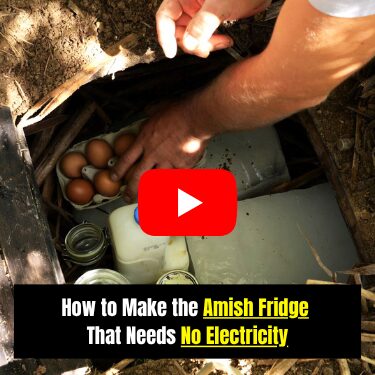
This is not just a clever storage trick; it’s a lifestyle choice that reconnects us to the rhythms of nature and the value of self-reliance. If you want to go a step further, there are even simple additions you can make to improve airflow and temperature regulation, turning your wooden box into a fully functional, zero-electric fridge.
You can find this project, alongside with hundreds of others inside The Amish Ways Book, a one-of-a-kind physical resource filled with time-tested survival tips straight from the Amish community.
For the first time ever, this 200-year old knowledge is available in a beautifully crafted physical book, written by Eddie Swartzentruber—someone who spent the first 16 years of his life living among the Amish. Secure your own physical copy today and 3 FREE GIFTS using my personal 76% discount coupon from here.
Concrete Block Cellar
If you have some concrete blocks lying around or can easily get a few, they make an excellent and sturdy alternative for creating a backyard root cellar. By stacking concrete blocks in a square or rectangular shape and filling the gaps with mortar or even just dirt, you create strong, insulated walls that hold cool temperatures well.
You’ll need to dig a hole to set the blocks in partially or fully underground, then build upward to create a small cellar space. You can add shelves made from reclaimed wood or pallets inside the structure for organizing your produce. Cover the top with a wooden or metal lid insulated with burlap or foam to help maintain temperature and moisture control.
Concrete block cellars are durable, pest-resistant, and great for long-term use. They’re ideal if you want a bit more permanence than a wooden box but don’t have the space or tools for a full dugout cellar.
Straw Bale Insulation
If you’re looking for a natural and insulating material that’s easy to find, straw bales make a great option for lining your root cellar hole. After digging your hole about 3 feet deep, you can line the sides and bottom with tightly packed straw bales to help regulate temperature and humidity inside the cellar.
Straw acts as a natural insulator, keeping the cool air trapped and preventing extreme temperature swings. Cover the top with a sturdy lid—wood works well—and then add another layer of straw or even soil on top for extra insulation. This method is especially good if you want to avoid plastic or synthetic liners and prefer something biodegradable and eco-friendly.
Straw bale cellars provide a breathable, moisture-balanced environment that’s perfect for storing root vegetables and other perishables. Plus, when it’s time to retire or move your root cellar, the straw can be composted or reused in your garden.
Clay or Ceramic Crocks
Clay or ceramic crocks make a great alternative for root cellar storage. Their semi-porous nature helps maintain ideal humidity levels by allowing just enough moisture exchange, which keeps root vegetables like carrots, potatoes, and onions from drying out or rotting too quickly.
These crocks are durable and can be partially buried underground for natural insulation. Most come with lids or can be covered with breathable materials like burlap or a wooden board to protect your food while still allowing some airflow.
Using crocks is a time-tested method for storing produce that benefits from a slightly moist environment, making them a perfect fit for your backyard root cellar setup without needing complicated construction.
Milk Can
There are many ways you can use a milk can for a variety of purposes and a backyard root-cellar is one of them. You might want to paint the exterior to delay the inevitable rusting, but the lid is usually a tight seal, and the cans are insulated so they will hold the internal temperature over time.
It’s moisture proof but here again you can make a lid with wood and burlap with some holes drilled in the lid if you want to vent or admit some moisture. If you’re buying an old milk can it’s okay to buy the most banged up, cheap one(s). After all, you’re just going to bury it, but it may still be wise to paint it.
5-Gallon Plastic Bucket
5-gallon plastic buckets are pretty cheap, but you should still try to buy one that is made of food-grade plastic. And don’t forget the lid if you want a tight seal.
It’s great for preserved or canned foods made of metal or with metal lids because it will give you an airtight, watertight seal to protect against rust. Many of the lids on plastic buckets allow you to twist the top to remove it and that makes access even easier. The only drawback is that they’re relatively small, but we’ll get to a solution for that in a moment.
And these buckets aren’t just for storing food. They can also be repurposed to solve another critical need in your root cellar setup: clean water. By stacking three empty buckets on top of each other, you can quickly build a 3 Bucket Water Filter in less than 30 minutes. This simple DIY filter is a lifesaver, especially when disaster strikes. After Hurricane Katrina, for example, many people found themselves surrounded by water, but unable to drink it because it was contaminated.
Having a reliable way to filter water right in your root cellar area can keep you hydrated and healthy when outside water sources are unsafe. So, food-grade buckets with lids don’t just protect your stored food. They can also be the foundation for clean water in an emergency.
Want clean water fast?
➡️ Learn how to build your own 3 Bucket Water Filter in under 30 minutes.
Garbage Can
A plastic or metal garbage can gets us back to higher volume storage. It’s also another easy solution. You just need to dig a hole deep enough to bury the can, backfill around it and the lid even has a handle.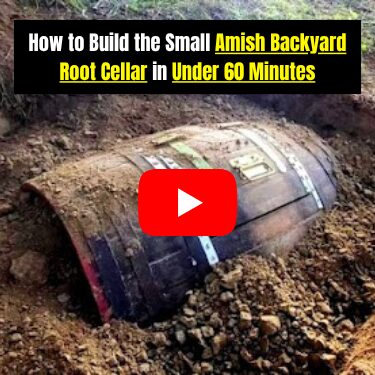
You can insulate the inside of the lid with foam or use that burlap and throw it over the top of everything to hold in a little bit more of the cooler temps. The cans are waterproof but if you want to allow some ground moisture to penetrate you can drill holes in the bottom. It’s a quick and easy solution and it works.
You can also build a small Amish root cellar using a trash can or an old blue barrel, just like the garbage can method mentioned earlier. By burying it in your backyard and insulating it properly, you create a simple yet effective underground storage space. This approach combines the ease of using repurposed materials with the time-tested benefits of Amish root cellaring, maintaining cool, stable temperatures and humidity to keep your produce fresh for months. It’s a practical, affordable way to bring a piece of Amish wisdom to your own home, even if you don’t have the space or resources for a full-sized root cellar.
Some General Notes About Your Backyard Root-Cellar
- Don’t forget to rotate what you store. That’s a general rule for any kind of food storage but that stuff at the bottom can rot or spoil in other ways if you forget it’s there.
- If you have an open bottom or are allowing water or moisture to penetrate, make sure you have an elevated floor or rack to keep the food at least 3-inches above the bottom. A heavy rain can fil your backyard root cellar with water temporarily and that’s not a good idea for any food that comes in contact with the water.
- You don’t have to choose just one of these designs or just bury one backyard root cellar. You could bury six 5-gallon buckets and vary what you store. You could also combine solutions using a garbage can for watertight storage of canned foods and a wooden box for a moist environment for root vegetables.
- Check your root-cellar foods at least weekly. If you notice any mold or spoilage on fresh vegetables, toss them in the compost heap. If you see rust on a canning jar lid or can, pull it and either throw it out or open it and do the test for appearance, smell and taste.
- Try to reserve or save the dirt from the hole you dig for your backyard root cellar. You may decide after a year or two to pull the root cellar or expand it and it’s a shame to buy a barrel sized bunch of dirt just to fill a hole.
➡️Add This To Your Stockpile To Increase Its Shelf Life
It Can Work
In the end, a backyard root cellar is a good everyday solution for food storage, especially if you have a large garden. It’s also a great backup plan for a power outage or for anyone living off-the-grid on a smaller piece of property. It all sort of makes sense and can even work on an extended camping trip. That’s up to you but it’s great to connect to those old pioneer ways and a root-cellar is a clear and cool connection to that past.
I Wish I’d Known This Before Building A Root Cellar
An Insanely Effective Way To Build A 5 Year Food Stockpile (Video)

